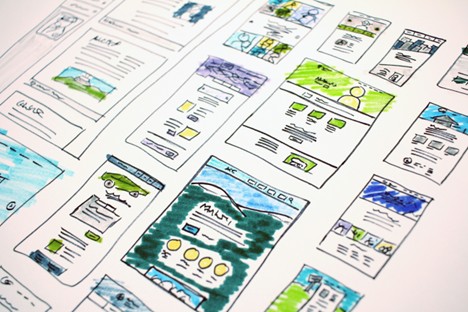As UX designers, we often focus on creating delightful digital experiences. But what if these experiences could also have a measurable impact on environmental sustainability?
This article is written for UX designers, researchers, and product teams seeking practical ways to reduce digital environmental impact through design. Through this article, we can explore how symbiotic interfaces (intelligent systems that collaborate with users) can guide greener digital habits without sacrificing usability.

Figure 1. Web design wireframes (Credit: Unsplash @ Hal Gatewood).
Why Sustainability in UX Matters More than Ever
UX designers are uniquely positioned to influence the shift to greener digital habits. After all, the interfaces we design shape user behavior at scale.
Major tech firms like Google™ and Microsoft™ are already moving toward greener infrastructure, and regulations like the European Union’s Digital Product Passport reflect growing expectations for sustainable tech (see Ecodesign for Sustainable Products Regulation).
A Quiet Problem with Loud Consequences
Each time we send an email, stream a video, or scroll endlessly through content, it consumes energy from fossil-fuel-based grids. According to The Shift Project, digital technologies contribute about 3.7% of global greenhouse gas emissions, and that’s rising fast (see Lean ICT – Towards Digital Sobriety). But it is not just about emissions. Every gigabyte of data transmitted over the internet can use up to 200 liters of water in cooling data centers, depending on local climate and infrastructure (see Data Centre Water Consumption).
Cloud storage, AI model training, and background syncing are all invisible processes with real-world environmental costs leading to freshwater depletion and rising energy bills.
Understanding Symbiotic UX Interfaces
We use the term symbiotic to describe a mutually beneficial relationship between
- The user, who wants speed, convenience, and personalization, and
- The interface, powered by AI, which adapts to user behavior and gently guides decisions that reduce environmental impact.
The goal is not to burden users with extra tasks, but to design experiences in which sustainable choices are embedded seamlessly, often invisibly.
The Research Framework: Where Design Meets Environmental Science
This study followed a mixed-methods approach based on sustainable interaction design (SID). I recruited a diverse group of 15 participants across five roles: general users, designers, sustainability experts, AI researchers, and academics. I conducted the following:
- Surveys with 500 respondents on digital behavior and sustainability awareness
- Thirty in-depth interviews to explore motivations and barriers
- Ten usability testing sessions with AI-powered prototype interfaces
- Interactive workshops in which participants co-designed solutions
Participant Snapshot
We ensured balanced representation in our sample.
| Participants | Roles | Background |
| P1-P3 | General Users, UX Designers | App design, non-profit tech |
| P4-P6 | Data Scientists, Sustainability Managers | Waste optimization, renewable energy |
| P7-P9 | Academics, AI Experts | HCI, climate modeling |
| P10-P12 | UX Designers, Researchers | Urban planning, digital systems |
| P13-P15 | Advocates, Designers | Digital minimalism, inclusive design |
Initial Reactions: Curiosity Meets Confusion
As participants explored real-time energy use data and engaged with prototype interfaces, the issue of energy usage became clearer. Why did it matter to them? Because energy demand varies: During peak hours, the grid pulls from dirtier sources, yet overnight, cleaner energy is more available. Preloading shifts demand to improve efficiency while delivering smoother usage (see Data Centre Water Consumption).
Figure 2. Usage Awareness dashboard.
Breakthrough Collaborations
As participants explored real-time energy use data and engaged with prototype interfaces, they began to understand the idea of symbiotic UX. These interfaces can adapt to user behavior while gently guiding better behaviors.
A key turning point was the AI Optimization Settings interface (Figure 3), which introduced participants to a set of features designed to reduce digital carbon footprint:
- Adaptive Scheduling, which learns usage patterns and shifts energy-heavy tasks to off-peak hours
- Smart Preloading, which downloads content when renewable energy is abundant
- Resource Cleanup, which automatically identifies and removes redundant files
- Quality Adaptation, which dynamically adjusts media quality based on energy availability
Participants quickly ideated based on this. One envisioned a binge-watch mode that preloads media overnight to ease server demand. Another suggested a declutter assistant that uses cloud analytics to clean unused files.
These weren’t just eco-friendly ideas—they added value. Users imagined faster load times, reduced data bills, and interfaces that worked for them and the planet.
Figure 3. Optimization Settings, as shown to participants.
Three Patterns Emerged
1. Real-time feedback drives change.
Dashboards that showed real-time energy use and a carbon footprint gave users new visibility into their digital behaviors.
“If I could see how much energy my habits cost—even something like endless tab-switching—I’d definitely adjust,” one participant noted.
However, visibility alone didn’t always lead to behavior change. It was when insights were paired with well-timed nudges or suggestions that action became more likely. This suggests a layered approach: first awareness, then facilitation.
2. Personalized nudges prevail over generic warnings.
AI-powered nudges like “Download now to save energy” were tested. Importantly, participants liked and acted upon these nudges:
- 72% of participants followed through on at least one energy-saving nudge.
- Background sync reduction nudges were accepted in 63% of instances.
- These actions contributed to a 23.4 kWh reduction in energy use during the test period.
3. Motivation develops through progress and personalization.
Some users appreciated gamified features like badges or leaderboards, but what truly drove engagement was seeing their personal progress. One participant said, “The badge was fun, but knowing I saved enough energy to power a lightbulb for a day really stuck with me.”
Instead of focusing on competition, the interfaces emphasized the following:
- Self-efficacy (“Your actions saved 3kg of CO2.”)
- Positive reinforcement (such as unlocking eco milestones)
- Goal framing (such as “Reduce energy by 10% this week!”)
Leaderboards were optional, and some participants hid them. The hook wasn’t winning; it was making a difference.
Figure 4. Gamification of user insights.
From One-Time Actions to Lasting Habits
Although users in the study were receptive to nudges, repetition alone didn’t form habits. Based on observed behavior, here are four directions that might help translate action into routine (see Tiny Habits: The Small Changes That Change Everything):
- Make it effortless: Set-and-forget tools like auto-cleanup require no ongoing effort.
- Anchor to existing behaviors: Nudges shown during natural tasks (such as uploads) feel contextual.
- Reinforce perceived impact: Concrete feedback like “You saved enough to power a fan for 3 hours” feels more meaningful.
- Reward consistency over intensity: Small, frequent wins (such as weekly streaks) help build momentum.
These nudges aren’t definitive but offer promising directions for teams looking to embed sustainability by design.
Measured Impact
The combined effect of dashboard visibility, nudges, and progressive feedback loops led to the following in participants:
- 85% reported increased sustainability awareness.
- 70% adopted at least one new eco-friendly behavior.
- 30% simulated a reduction in energy use.
- 45% decreased unnecessary data processing.
| Design Intervention | Estimated Impact (per User/Year) | Source |
| Reducing background sync (auto-off when idle) | Saves approximately 9-12 kWh of energy | Prototype testing; IEA, 2022 (see Data Centres and Data Transmission Networks) |
| Smart preloading for streaming | Reduces peak load energy demand by approximately 15% | Modeled after Netflix™ efficiency studies (see Is Netflix Succeeding in Making Streaming Greener?) |
| Intelligent cloud cleanup nudges | Reclaims approximately 20-30 GB/year | Internal prototype logs |
Looking Ahead
This research suggests that UX designers can play a vital role in driving sustainable digital behavior, but we must go beyond the surface impact. We need to design interfaces that anticipate, guide, and reinforce the right behavior without friction.
Future directions include these:
- Deeper integration with IoT to track energy across devices (see Accenture Retail Sustainability)
- Predictive AI that adapts to evolving usage patterns
Sustainability in UX isn’t just a feature; it is a mindset that treats energy, attention, and environmental impact as design materials. If we embed these values into our interfaces, we can build better products, and we can help shape better digital citizens.
More Reading
Lean ICT – Towards Digital Sobriety
International Energy Agency: Data Centres and Data Transmission Networks
Ecodesign for Sustainable Products Regulation
Is Netflix Succeeding in Making Streaming Greener?
Tiny Habits: The Small Changes That Change Everything
Accenture Retail Sustainability
Aashish Manchanda is a Senior Product Designer at Cisco Systems who specializes in sustainable UX design and AI-driven interfaces. With over eight years of experience in the tech industry, he focuses on creating user-centric solutions that bridge the gap between technology and environmental consciousness. His work has been featured in multiple international design conferences and publications. Contact Aashish at linkedin.com/in/aashish-manchanda/.


User Experience Magazine › Forums › Designing for the Planet: Interfaces That Encourage Greener Digital Behavior